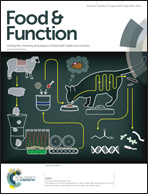One-step formation of a double Pickering emulsion via modulation of the oil phase composition†
Abstract
There are two long-standing issues that are holding back the full exploitation of food-based double emulsions: (i) unavailability of large-scale equipment to ensure efficient nondestructive two-step emulsification and (ii) limited food-grade ingredients available to replace polyglycerol polyricinoleate (PGPR) as the primary emulsifier. To overcome these, a facile one-step emulsification strategy was developed to generate a food-grade W/O/W double Pickering emulsion by using corn-peptide-functionalized calcium phosphate (CP-CaP) particles as the emulsifier. It was demonstrated that the wettability of such CP-CaP particles can be tuned through modulation of the oil phase composition. The incorporation of health benefiting ω-3 oils (algal oil) or essential polyunsaturated fatty acids (linoleic acid and linolenic acid) into common vegetable oils leads to the hydrophobization of a fraction of CP-CaP particles through in situ adsorption of the free fatty acids, which provide satisfactory stabilization of both O/W and W/O interfaces, thus generating stable double Pickering emulsions. Moreover, the algal oil-loaded double Pickering emulsions that incorporate water-soluble isoascorbic acid show improvement in both their oxidative stability and flavor properties. This study demonstrated that the edible CP-CaP particle based double Pickering emulsions have promising potential to be applied in the food industry.



 Please wait while we load your content...
Please wait while we load your content...